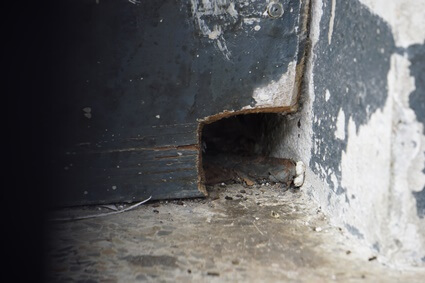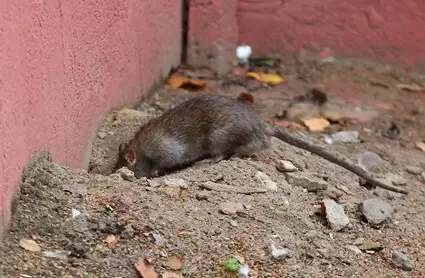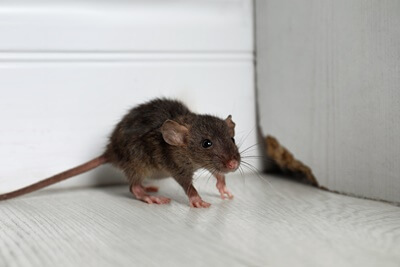Rats like the walls of a home as they’re warm, secretive, and difficult for other animals to access.
So, they make good hiding spots and nesting locations. However, walls are tightly sealed from the outside world, so it can be hard to understand how rats gain access.
Because rats’ teeth are so hard, they can chew through brick, wood, thin metal, and drywall.
Rats can also gain access through other weaknesses in the wall, such as around the AC unit and under skirting boards. If there are any gaps, a home’s walls are vulnerable to rats.
You can’t leave a rat in your wall, so you’ll need to lure them out with bait and seal the holes so that other rats can’t enter. If a rat dies inside a wall, someone must dismantle and remove it.
Can Rats Break Through Walls?
Rats can break through walls if given sufficient time.
Most homes have drywall, which is composed of plasterboard and chalk. These materials are significantly weaker than rats’ teeth, so they can easily get through.
This is true for other wall types, as rats can chew through wood and certain metals. That’s possible because rats have strong teeth that grow throughout their lives.
They must constantly grind their teeth to prevent them from extending too far. Rats’ teeth are 5.5 on the Mohs hardness scale, meaning they’re harder than certain kinds of steel.
Rats’ jaws are anchored in their eye sockets to deliver a strong bite.
According to the North American Exotic Animal Practice, this unique anatomy makes it possible for rats to chew most walling material, including:
- Wood
- Brick
- Sheetrock
- Drywall
- Concrete
When motivated, a rat can quickly create a large hole in a wall.

How Long Does It Take a Rat to Chew Through a Wall?
The amount of time it takes for a rat to chew through a wall depends on two factors:
- Material type
- Wall thickness
According to PLOS Neglected Tropical Diseases, households with structural deficiencies, such as unplastered walls, are more susceptible to rat infestations.
That’s because rats can chew into thinner walls faster, and the lack of plaster makes drywall softer, allowing rats to enter buildings.
A rat can chew through a thin, soft wall made of drywall or wood in just 2 hours. If the wall has several layers, it can take 1-2 weeks for rats to chew through.
How Do Rats Travel Through Walls?
Given their diminutive size and flexibility, rats can travel in wall interiors.
They create pathways inside the wall cavity, chewing through insulation and wiring to journey onward. Electrical conduits, pipes, and foam can be transformed into a network of rodent pathways.
Rats will then tunnel throughout your home, gaining access to different areas without interacting with humans and predators.
Even if rats didn’t chew into the wall, they could find unconventional access points, including exposed roof vents, gaps in roof eaves and edges, and other ground-level locations, such as AC chassis.
If you have holes in the wall structure, it’s easy for a rat to squeeze through and lodge itself in a wall.
What Do Rats in Walls Sound Like?
If rats hide inside walls, you may hear squeaking and scratching noises as they perform their daily activities. Also, you may hear gnawing sounds when they’re chewing on items.
If you listen closely, you’ll likely hear the pattering of feet as they scurry back and forth.
How Long Can a Rat Live in a Wall?
Wall cavities are among the safest places for rats to live indoors. If no efforts are made to remove them, rats can stay there all their lives.
If rats have access to nearby food and water, they’ll have no incentive to leave an internal wall. However, without food, a rat trapped inside a wall will die of starvation after only four days.
If a rat dies in a wall, it must be removed, or it’ll start to smell.
Why Do Rats Go Into Walls?
Rats are attracted to walls for the following reasons:
- A secure shelter away from predators, such as ferrets and schnauzers.
- Hiding places that rats can scurry to when spotted.
- Warmer, since heaters and heating systems are often installed against them.
- It is a source of food because insulation can be consumed when hungry.
- It is a way to travel around the home since most walls share open spaces.
Nests built inside walls are comfortable and conducive for breeding and raising young ones. Also, the materials inside the walls provide ready material for nest-building.
Wires, insulation, drywall, and plasterboard are perfect resources to strip down and collect.
How To Cover Holes in Walls from Rats
If you have holes in your walls, there’s a high chance that a rat will use them.
Even one of these openings can allow rats to enter your house and wreak havoc on your property. Therefore, it’s vital to cover all potential access points.
Here’s a step-by-step guide on how to restrict access to internal walls:
Locate Holes in Walls
When rat-proofing your walls, carefully examine them from top to bottom.
Rats are good climbers, especially when using the insulation, pipes, and wiring in your walls as ladders. So, you may find holes at ceiling level, especially if they lead out onto shelving or bookcases.
The most common holes will be along the floor, especially in corners or behind furniture. For the exterior of your home, check out-of-sight areas, including patches of walls covered with plants or bushes.
Plug Holes with Steel Wool
Once you identify holes in your walls, fill them with wire mesh or steel wool.
Rats can chew through this material, but the mesh design makes it more difficult. The metal will stick in their teeth and be difficult to tear, making it harder for rats to chew.
Seal the Holes with Cement
Rats can get through both measures, so you’ll need a thicker material. Mix cement and apply it to the holes to seal the hold completely.
You can mix the cement with broken glass shards to provide maximum protection. This will keep rats from chewing the cement, as their mouths will experience lacerations.
How To Remove Rats in Walls
When rats choose to nest inside walls, they can cause damage to your property. Rats can compromise the structural integrity of your home and create fire hazards.
If a rat dies inside your walls, removing it can be costly and inconvenient. You may need to remove the wall to reach it, as leaving the dead rat in your wall will create a foul odor.
Removing rats before they create a bigger problem is vital, so here’s how to do so:
Lure Rats Out
Rats living in walls will come out several times a day (usually at night) to search for food.
This presents an ideal chance to catch them. Set up various traps baited with cheese or peanut butter in locations where you’ve noticed signs of rats.
You can use a snap trap (if you intend to kill the rats) or a live trap if you prefer a more humane removal method. Check the traps twice a day to see if you’ve captured a dead or alive rat.
If you find live rats caught in your traps, put them in a heavy-duty plastic bag and release them in the wild. This should be far from your house, in a woodland area, so they cannot find their way back.
If you find dead rats in your trap, transfer them to a plastic bag and put them in the outdoor garbage can. Always wear protective gloves when handling rats.

Rodenticides
Poisonous pellets can eliminate rats living in your walls. However, you must be cautious, as they can have unwanted consequences.
For instance, a rat may ingest a poisonous pellet and carry poison back to its nest inside the walls, causing one or more rats to die there.
While you’ll no longer have a rat problem, you’ll have to deal with the stench of decomposing rats from your walls. Worse still, one of your pets or children may ingest the pellets and fall ill.
If you decide to use poisoned pellets, set your bait station in a location near a food source but out of reach of pets and children.
Natural Rat Repellents
Natural rat repellents are organic products that create unpleasant scents for rats.
These include essential oils, such as:
- Eucalyptus
- Citronella
- Lavender
- Peppermint
It can also involve common foodstuffs, such as garlic and onion. Most people prefer using natural rat repellents since they don’t contaminate the environment.
Douse cotton wool balls with the oil of your choice and place them near holes that rats enter. The pungent smell will cause rats to stay away.
How Long Does It Take to Get Rats Out of Your Walls?
Removing rats from walls is a process that involves two separate but related activities:
- Sealing all holes in walls
- Waiting for rats to perish before removing them
Start by sealing the exterior of the walls to prevent future rat infestations. The amount of time it takes to seal exterior walls depends on their condition.
If the walls have badly deteriorated and there are multiple entry points, the process will be more complicated and time-consuming.








